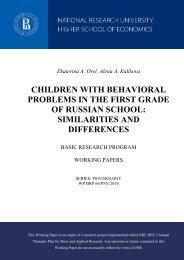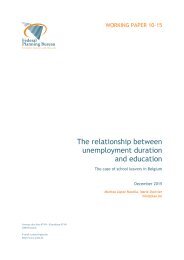Ten-Year Impacts of Burkina Faso’s BRIGHT Program
n?u=RePEc:mpr:mprres:2ecdd42bb503422b802ce20da2bf64b7&r=edu
n?u=RePEc:mpr:mprres:2ecdd42bb503422b802ce20da2bf64b7&r=edu
You also want an ePaper? Increase the reach of your titles
YUMPU automatically turns print PDFs into web optimized ePapers that Google loves.
APPENDIX A<br />
MATHEMATICA POLICY RESEARCH<br />
The selection algorithm described in Chapter II creates a series <strong>of</strong> RD designs within each<br />
department. However, this implies that different departments used different cut<strong>of</strong>f points to<br />
select the top half <strong>of</strong> their ranked villages to receive the <strong>BRIGHT</strong> program. To transform the<br />
score variable used to assign schools such that all villages received the <strong>BRIGHT</strong> program if their<br />
score was larger than the same value, we calculate for each department the midpoint between the<br />
scores <strong>of</strong> the highest-scoring village not assigned to receive the program via the algorithm and<br />
the lowest-scoring village assigned to receive it. The variable _ is then defined to be<br />
the village score relative to this mid-point. It is the value <strong>of</strong> the mid-point subtracted from each<br />
village’s score. Although the within-department assignment rule is not statistically ideal, we<br />
include department-level fixed effects in all estimations to ensure that villages are compared only<br />
to other villages within the same department.<br />
We estimate treatment effects via the following model using ordinary least squares:<br />
= + + (_ ) + δ + + <br />
(A.1)<br />
The estimates are performed at the child level, with each child designated as child in<br />
household h in village in department . We designate the outcome <strong>of</strong> interest with the variable<br />
. The matrix is a vector <strong>of</strong> department fixed effects, and includes child and<br />
household demographic characteristics. Specifically, the set <strong>of</strong> characteristics includes those<br />
variables listed in Table B.2 in Appendix B. 52 The indicator variable is set to one if the<br />
selection algorithm designated the child’s village to receive the <strong>BRIGHT</strong> program;<br />
(_ ) is a polynomial expansion in the relative score <strong>of</strong> the village. Because the MEBA<br />
assigned the treatment at the village level, we cluster the standard errors at the village level using<br />
the standard Huber-White estimator.<br />
As in Kazianga et al. (2013), we find the score variable is uncorrelated with most outcomes.<br />
This allows for the use <strong>of</strong> a low-ordered polynomial. Following the previous paper, we use a<br />
quadratic specification as our preferred one while using other orders in robustness checks. All <strong>of</strong><br />
the results are robust to polynomials <strong>of</strong> other orders. Additionally, because the coefficients on the<br />
score variables are so small, we measure the relative score variables in units <strong>of</strong> 10,000. 53<br />
Finally, we conduct an additional robustness check for our main outcomes (assignment to<br />
<strong>BRIGHT</strong>, enrollment, and total test scores) in which we estimate the location <strong>of</strong> the discontinuity<br />
using the estimation technique proposed by Card et al. (2008) and Hansen (2000). The technique<br />
involves estimating the following model for all values <strong>of</strong> in the range <strong>of</strong> _ :<br />
= + (_ ) + <br />
(A.2)<br />
52<br />
For parsimony, we have consolidated some <strong>of</strong> the control variables into the indexes presented in Table B.2.<br />
However, the results are invariant to including the individual components <strong>of</strong> the index instead.<br />
53<br />
The details <strong>of</strong> the scoring formula are available in Kazianga et al. (2013).<br />
A.3







